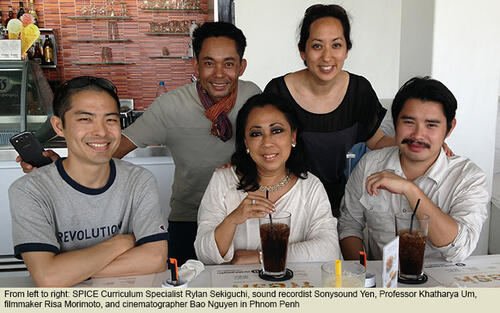Rylan Sekiguchi receives Buchanan Prize for his work on Cambodia
Rylan Sekiguchi receives Buchanan Prize for his work on Cambodia

Established in 1995 by the Association for Asian Studies, the Franklin Buchanan Prize is awarded annually to recognize an outstanding curriculum publication on Asia designed for any educational level, elementary through university.
91łÔąĎ Curriculum Specialist and independent filmmaker Risa Morimoto have won the 2015 Buchanan Prize for their work on —a multimedia curriculum project that features documentary films, primary source readings, student handouts, and a full menu of classroom activities. All materials are available for free on the 91łÔąĎ website, .
Sekiguchi formally accepted the award at the 2015 Association for Asian Studies Annual Conference in Chicago. Before presenting the Buchanan Prize, AAS President Mrinalini Sinha praised the publication, explaining why it deserved the distinction: “This self-contained online unit is a refreshing update to available Cambodian studies resources at the high school and community college level, going beyond The Killing Fields to bring new information and perspectives from Cambodians and Cambodian-Americans to key themes that span the social studies curriculum.” Following the award ceremony, Sekiguchi was congratulated by AAS Executive Director Michael Paschal. Sekiguchi is a two-time recipient of the prize and the sixth time for 91łÔąĎ.
Background and Synopses of Films
In 1975, a radical new government assumed power in Cambodia and drastically transformed the country. Religion was outlawed, and money was abolished. Mass executions were sanctioned by the state. By the time the regime was toppled four years later, an estimated two million people—about 25 percent of the country’s population—had died from disease, starvation, forced labor, imprisonment, and execution.
In response to this tremendous upheaval, many Cambodians fled their homes for other countries, including the United States. How have Cambodian individuals and communities come to terms with their forced resettlement? What are the social and cultural implications of Cambodia’s turbulent history for Cambodians and Cambodian Americans today, more than a generation after the genocide and mass exodus? These issues are explored through documentary films that profile two Cambodian Americans as they remember and try to reconnect with their ancestral homeland.

The first film, My Cambodia, follows a scholar and former refugee—Professor , U.C. Berkeley—as she returns to Cambodia and describes the genocide’s history as well as its profound legacies. Upon hearing about the Buchanan Prize, Um remarked, “[Thank] you all for making our whispered stories audible to others.” In addition to appearing in the film, Professor Um served as an academic consultant to Morimoto and Sekiguchi. She is the first Cambodian woman to receive a Ph.D. in the United States.
The second film, My Cambodian America, highlights a young photographer, , as he travels around the United States to capture the stories and scenes of various Cambodian-American individuals and communities. Through the film, students become acquainted with Cambodian and Cambodian-American history and begin to consider some of the complex issues that are raised by that history. “All immigrants share the same story of cultural assimilation, loss of culture, loss of language amongst…the younger generations,” Pin notes in the film. “And that’s absolutely true with Cambodians, but then you have in addition to that the added layer of having survived one of the great atrocities of the 20th century.”
A Trip to Cambodia
In 2013, Rylan Sekiguchi, Risa Morimoto, Professor Um, and cinematographer traveled to Cambodia to shoot My Cambodia. Reflecting back on the trip, Risa mused about how the structure of the film began to take focus before her eyes. “Professor Um’s personal experience gave us an intimate look into how this tragic history unfolded. It was impossible not to be deeply affected.” She also commented on how the once-in-a-lifetime experience helped her to conceptualize My Cambodian America as the trip gave her a glimpse into the homeland of Cambodian Americans.

A Bridge Between Higher Education and High Schools
The accompanying teacher’s guide offers suggested lesson plans and provides classroom materials that supplement the information and issues explored in the films: context-setting activities, note-taking handouts, answer keys, discussion questions, and numerous extension activities. “I am so proud of Rylan and Risa’s directing of the films and Rylan’s crafting of the teacher’s guide,” remarked 91łÔąĎ Director . “The films/teacher’s guide package is an excellent example of making academic scholarship—namely that of Professor Khatharya Um—accessible to high school students, and teaching young students about ways to consider and capture—for example, through Pete Pin’s photographs—the relationship between diasporas and homelands.”
To view My Cambodia, please visit ; to view My Cambodian America, visit .
To download the Teacher’s Guide and other supplementary teaching materials, go to .
